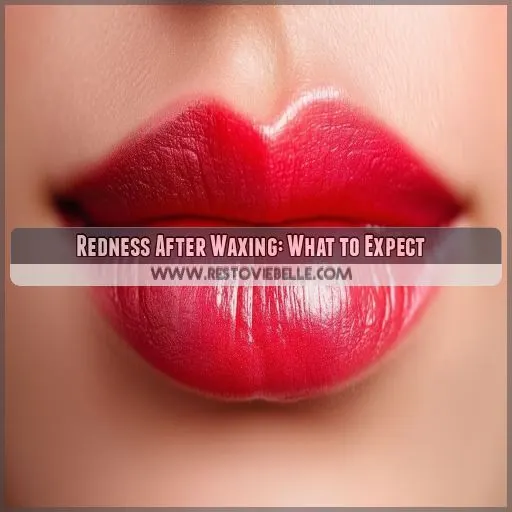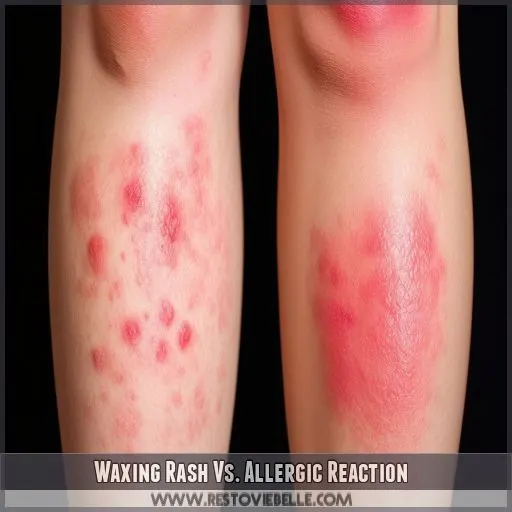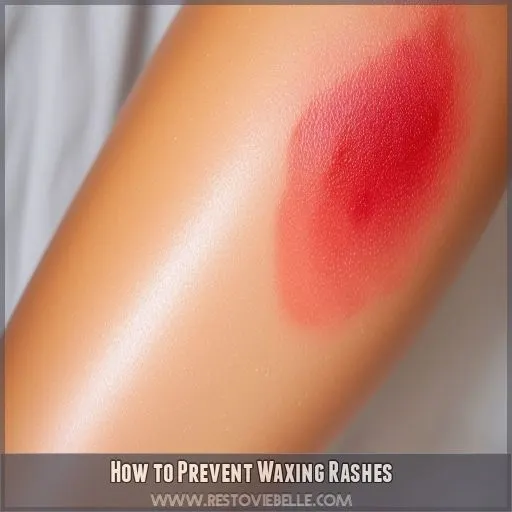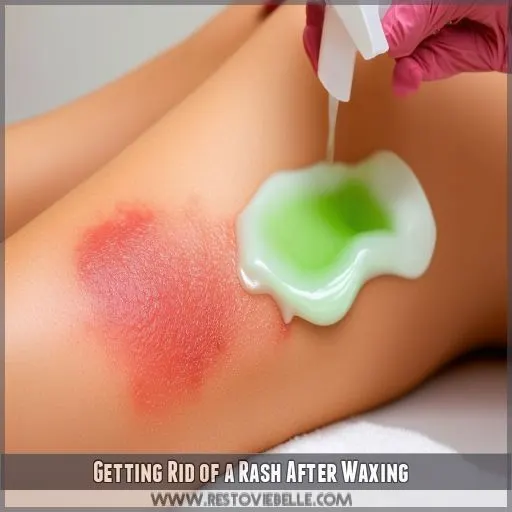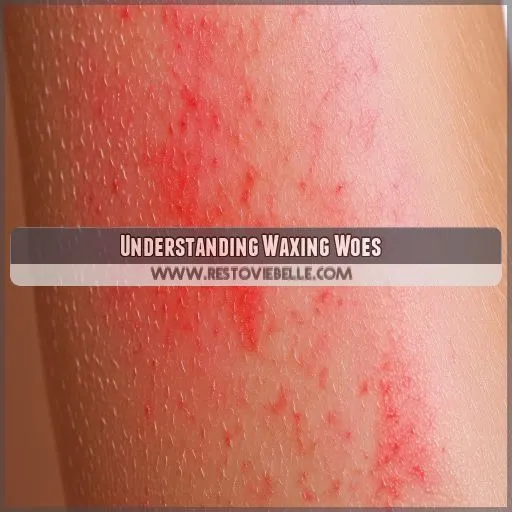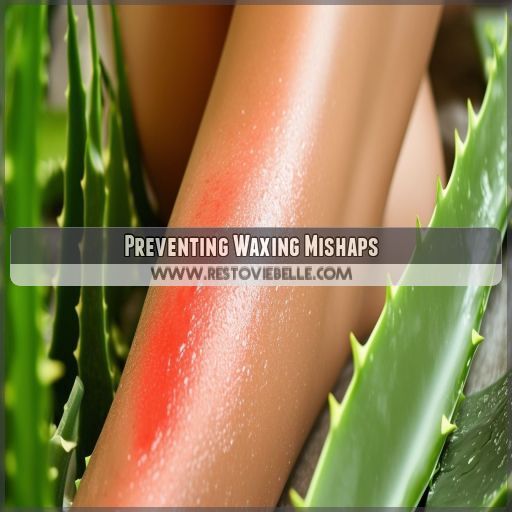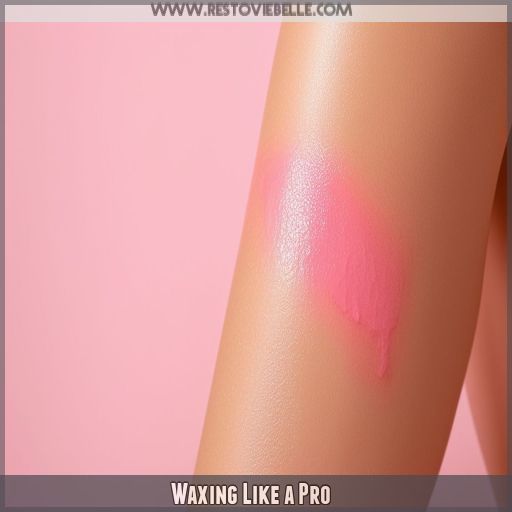This site is supported by our readers. We may earn a commission, at no cost to you, if you purchase through links.
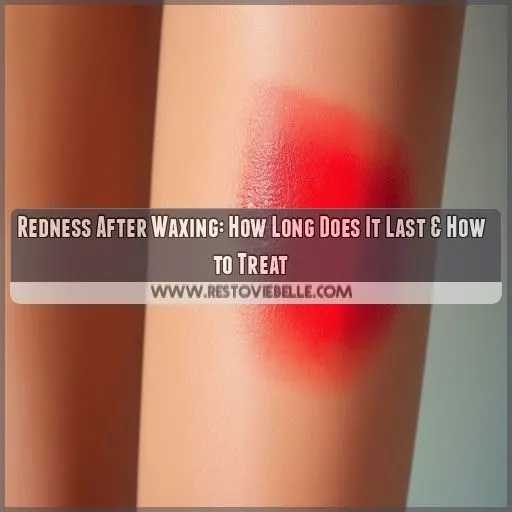 Wondering how long you’ll be sporting that post-wax glow (or should we say, redness)?
Wondering how long you’ll be sporting that post-wax glow (or should we say, redness)?
Don’t worry, you’re not alone! Typically, redness after waxing lasts anywhere from a few minutes to a few hours.
If you’ve got sensitive skin, it might stick around until the next morning, like an uninvited houseguest. The duration depends on factors like your skin type and the area waxed.
Some folks bounce back faster than a rubber band, while others need a bit more TLC. Remember, everyone’s skin tells a different story.
Curious about how to speed up the recovery process and keep your skin happy? Let’s smooth things out together!
Table Of Contents
- Key Takeaways
- Redness After Waxing: What to Expect
- Clothing Comfort for Healing
- Waxing Rash Vs. Allergic Reaction
- How to Prevent Waxing Rashes
- Getting Rid of a Rash After Waxing
- Understanding Waxing Woes
- Preventing Waxing Mishaps
- Waxing Like a Pro
- Frequently Asked Questions (FAQs)
- How long does skin stay red after waxing?
- What does a bad reaction look like after waxing?
- How long are your pores open after waxing?
- How to heal skin after waxing?
- Can certain medications increase redness after waxing?
- Does skin tone affect the visibility of post-wax redness?
- How does menstrual cycle timing impact waxing redness?
- Can diet influence the duration of waxing-induced redness?
- Does age affect skins recovery time from waxing redness?
- Conclusion
Key Takeaways
- Redness after waxing is as common as a bad hair day, typically lasting a few hours to a day. But don’t sweat it – your skin’s just throwing a little tantrum after its hair-removal workout!
- Your skin type is the director of this post-wax drama. Sensitive souls might see the redness sticking around until the next morning, like an uninvited houseguest who just won’t take the hint.
- Proper aftercare is your skin’s BFF. Think cold compresses, gentle cleansers, and moisturizers without funky fragrances. It’s like giving your skin a soothing spa day after its waxing adventure.
- If your redness decides to overstay its welcome (we’re talking more than a few days), it might be time to call in the dermatologist cavalry. Better safe than sorry when it comes to your skin, right?
Redness After Waxing: What to Expect
So, you’ve gone and got yourself a wax, and now you’re rocking some redness. First off, don’t panic – it’s totally normal to have some redness after waxing. We’re here to give you the lowdown on what to expect and how to handle it like a pro.
How Long Does Redness Last?
Typically, redness after waxing lasts only a few hours to a day. However, sensitive skin may experience prolonged redness. Here are some key points to remember:
- It’s normal to experience redness after waxing due to minor skin trauma.
- The duration of redness can vary, typically lasting a few hours up to a day.
- Sensitive skin may take longer to recover, so extra care is needed.
- If redness persists for more than a few days, it’s best to consult a dermatologist.
Factors Affecting Redness Severity
So, what’s causing that post-wax redness? Well, it’s a mix of things. First off, it’s totally normal to have sensitive skin after waxing – it’s a bit of a shock to the system. But the severity of redness depends on a few factors:
- Skin sensitivity: If you’ve got sensitive skin, you might experience more redness and irritation.
- Hair thickness: Thicker hair can lead to more redness as it’s a bigger deal for your skin to yank those bad boys out.
- Skin type: Different skin types react differently. For example, dry skin might be more prone to redness.
- Waxing technique: If the wax is too hot or applied incorrectly, it can irritate your skin and cause more redness.
Managing Redness and Inflammation
Redness after waxing is totally normal, but there are some easy ways to manage it. First, don’t panic! Redness usually lasts a few hours to a day, and there are simple remedies to speed up the healing process:
- Reach for cooling products like aloe vera gel or a cold compress to reduce inflammation and soothe irritated skin.
- Avoid the temptation to scratch or rub the area, as this can make inflammation worse.
- If redness persists for more than a few days, check in with your dermatologist.
Clothing Comfort for Healing
After a wax, what you wear can make a big difference. The right clothes can help soothe your skin, while the wrong ones can make it feel even more irritated.
Loose, Breathable Fabrics for Skin Health
For healing irritated skin, comfort is key. Think loose and breathable fabrics that give your skin some breathing room and reduce friction. You don’t want anything tight that might rub and irritate your skin further.
| Do’s | Don’ts | |
| 1 | Wear loose-fitting clothes that allow your skin to breathe. | Don’t opt for tight clothing that might cause friction. |
| 2 | Choose breathable fabrics like cotton or linen. | Avoid synthetic materials that trap heat and moisture. |
| 3 | Keep the area well-ventilated. | Don’t cover up with layers that might cause sweating and further irritation. |
Avoiding Synthetic Materials and Irritation
While you’re healing, it’s best to avoid synthetic materials like the plague. These fabrics trap heat and moisture, causing further irritation and slowing down the healing process.
The last thing you want is to feel like your skin is suffocating under a layer of synthetic fabric. It’s like wrapping yourself in plastic wrap and hoping for a breeze – it’s just not gonna happen!
Opting for Cotton or Linen for Healing
Opt for natural fabrics like cotton and linen to keep skin irritation at bay. These breathable fabrics are gentle on the skin and help speed up the healing process. They’re like a hug for your skin, keeping it comfy and happy while it recovers from the minor trauma of waxing.
Waxing Rash Vs. Allergic Reaction
While redness and irritation are common post-waxing, you might wonder if those red bumps are a waxing rash or an allergic reaction. It’s important to tell the difference between the two, as a waxing rash is typically mild and temporary, while an allergic reaction can be more severe and require immediate medical attention.
Distinguishing Between Mild and Severe Responses
It’s important to distinguish between a mild skin irritation and a more severe allergic reaction after waxing.
A waxing rash is a common, temporary response, marked by red, itchy bumps from inflamed hair follicles. This usually clears up in a few days.
A waxing allergic reaction is more serious and often involves hives, swelling, and breathing issues.
If you experience these symptoms, seek medical attention right away.
Symptoms of a Waxing Allergic Reaction
While a waxing rash is a mild irritation, a waxing allergic reaction is more severe and requires immediate medical attention. Symptoms of an allergic reaction include hives, swelling, and difficulty breathing. If you experience these symptoms, don’t delay—seek medical help right away.
Preventing Rashes and Reactions With Quality Wax
To prevent rashes and allergic reactions, it’s really important to use quality wax from reputable brands.
Check the ingredients for potential allergens like tea tree, lavender, or cocoa. Be cautious if you’re allergic to artificial colors, fragrances, or other ingredients.
Always inform your waxing technician about any allergies, and inquire about the products they use.
Choosing a qualified technician who uses quality wax can make all the difference in preventing unwanted reactions.
How to Prevent Waxing Rashes
If you’re prone to waxing rashes, prevention is key. You can minimize the chances of developing those pesky red bumps by taking a few simple steps before and after your wax treatment.
We’ll walk you through the essentials, from prepping your skin to choosing the right technician, so you can bid farewell to waxing rashes and embrace smooth, irritation-free skin.
Exfoliating Before Waxing for Skin Health
Exfoliating your skin before waxing is like giving it a fresh start. It’s like saying, "Hello, beautiful skin! Let’s get ready for some smooth moves." Here’s why this step is important:
- Out with the old, in with the new: Exfoliating removes dead skin cells, creating a clean canvas for hair removal. Think of it as spring cleaning for your skin – a chance to sweep away the old and welcome the new.
- Smooth operator: Exfoliation helps prevent ingrown hairs, which can be a real buzzkill after waxing. It creates a smooth path for hair removal, making sure those pesky hairs don’t get trapped under the surface.
- Calm and collected: Regular exfoliation keeps your skin calm and happy. It’s like giving your skin a gentle massage, preparing it for the waxing process and reducing the chances of irritation.
So, how do you exfoliate like a pro? Here’s a quick checklist:
- Choose a gentle exfoliator suitable for sensitive skin. You don’t want to go too harsh on your skin, especially before waxing.
- Exfoliate a few days before your waxing appointment. This gives your skin time to recover and makes sure it’s not too sensitive on the day of your wax.
- Be gentle! Use light, circular motions, and avoid scrubbing too hard. Your skin will thank you for it.
Avoiding Waxing With Active Acne or Skin Conditions
If you have active acne or other skin conditions, it’s best to avoid waxing.
Why? Well, waxing can irritate your skin further, and that’s the last thing you want.
It’s like pouring fuel on a fire.
You don’t want to make your skin issues worse, so it’s a good idea to hold off on waxing until your skin has calmed down.
Choosing a Qualified Wax Technician
When choosing a wax technician, experience, qualifications, training, and certification are key.
Opt for a reputable salon or spa with licensed estheticians or cosmetologists.
Ask about their training and certification in waxing services.
A qualified technician should have experience in different waxing techniques and be able to customize the treatment for your skin type and sensitivity.
They should also be knowledgeable about pre- and post-wax care, ensuring a comfortable and safe experience.
Getting Rid of a Rash After Waxing
So, you’ve got a waxing rash, and you want it gone—fast. No worries, we’ve got your back (or leg, or wherever that rash decided to rear its bumpy head).
Applying Cold Compresses for Inflammation
If you’re dealing with a waxing rash, cold compresses are your new BFF. They’re like a hug for your skin, calming inflammation and taking down the redness a notch. Think of them as nature’s anti-inflammatory to the rescue.
To use a cold compress, wrap some ice cubes in a clean, thin towel or gauze. Gently press it on the rash for a soothing sensation. You can also use a gel ice pack, but make sure to wrap it first to avoid direct contact with your skin.
Moisturizing With Gentle, Fragrance-Free Lotions
When dealing with a waxing rash, it’s important to keep the skin moisturized. Opt for gentle, fragrance-free lotions to avoid further irritating the skin. Here are some tips to keep in mind:
- Choose a moisturizer designed for sensitive skin.
- Look for natural, organic ingredients.
- Avoid harsh chemicals and fragrances.
- Apply the lotion generously to the affected area to soothe and hydrate the skin.
Cleansing With Mild, Fragrance-Free Cleansers
When faced with a waxing rash, it’s important to be gentle with your skin. Cleanse the area with a mild, fragrance-free cleanser to remove any dirt or bacteria that might irritate your skin further. Opt for gentle, hydrating formulas that won’t strip your skin of its natural oils, and always pat the area dry with a soft towel.
Understanding Waxing Woes
Whether it’s your first time waxing or you’re a seasoned pro, understanding the common issues that can arise is key to keeping your skin happy and healthy. In this section, we’ll explore the causes of redness and irritation, improper waxing techniques, overly sensitive skin, and allergic reactions, so you can tackle these waxing woes head-on and enjoy smooth, bump-free skin.
Redness and Irritation Causes
Ever felt like your skin’s throwing a tantrum after waxing?
You’re not alone! Redness and irritation are as common as bad hair days.
Your skin’s just reacting to the mini-trauma of hair removal. It’s like your skin’s saying, "Hey, what gives?"
Sensitive souls might’ve it worse, but don’t fret. Understanding these waxing woes is the first step to smoother sailing.
Let’s unpack why your skin’s seeing red!
Improper Waxing Technique and Allergens
Ever felt like your waxing experience was more ouch than oooh?
Improper technique might be the culprit. When wax is too hot or applied against the grain, it’s a recipe for irritation.
And don’t get us started on sneaky allergens! Some waxing products can be like wolves in sheep’s clothing, causing unexpected reactions.
But don’t worry, we’ve got your back. Let’s smooth out those bumps in your hair removal journey!
Overly Sensitive Skin and Allergic Reactions
If you’ve got sensitive skin, waxing can be a real pain.
Your skin might rebel with redness that lingers longer than usual.
And let’s not forget allergic reactions – they’re like uninvited guests at a party.
Some folks’ skin just doesn’t play nice with certain waxing products.
It’s super important to listen to your skin and choose products that won’t start a riot on your body.
Preventing Waxing Mishaps
You can prevent waxing mishaps by taking a few simple precautions before your appointment. From checking ingredients to prepping your skin, these steps will help make your wax smoother, less irritating, and overall a better experience.
Checking Wax Ingredients for Allergens
Before you get waxed, play detective with those ingredient lists!
Some waxes contain sneaky allergens like tea tree, lavender, or cocoa.
Don’t let your skin throw a fit – keep an eye out for artificial colors and fragrances too.
It’s like a treasure hunt, but instead of gold, you’re avoiding itchy bumps.
Your skin will thank you for being so savvy!
Informing Waxing Technicians of Allergies
Honesty’s the best policy when it comes to waxing. Let your technician know about any allergies you have before they start. This open communication builds trust and keeps you safe. Here’s a quick checklist to help you out:
- List all known allergies, even if they seem unrelated
- Ask about the ingredients in their wax products
- Mention any past reactions to beauty treatments
- Request a patch test if you’re unsure
Exfoliating and Preparing Skin Before Waxing
Ready to tackle that pre-wax prep?
Don’t sweat it! Gently exfoliate your skin a day or two before your appointment.
It’s like sweeping the floor before mopping – you’re clearing the way for a smooth wax.
Use a soft scrub or loofah to buff away dead skin cells.
This little trick helps prevent ingrown hairs and makes sure the wax gets a better grip on those pesky strands.
Your skin will thank you!
Waxing Like a Pro
You don’t need to be a pro to wax like one. With a few simple tips, you’ll be on your way to smoother skin and less redness in no time.
Avoiding Retinol and Exfoliating Acids
Want to wax like a pro?
Here’s a tip: steer clear of retinol and exfoliating acids before your session. These skin-sloughing superheroes can make your skin extra sensitive.
Turning your wax into a real ouch-fest is not what you want. It’s like trying to peel a banana that’s not quite ripe – you’ll end up with a mess!
Give your skin a break from these products for a few days pre and post-wax for smoother sailing.
Cleansing Skin Before Waxing
Let’s talk about prepping your skin for wax.
You wouldn’t paint a dirty canvas, right? Same goes for waxing.
Before you get started, give your skin a gentle cleanse. It’s like setting the stage for a smooth performance.
Use a mild soap to wash away any dirt, oil, or makeup. This’ll help the wax grip those pesky hairs better, making your waxing session a breeze.
Ensuring Wax is Not Too Hot to Avoid Burns
Let’s talk temperature.
You don’t want your wax to be hotter than a summer sidewalk!
Test it on your wrist first – if it feels like a warm hug, you’re good to go.
But if it’s screaming "ouch," cool it down.
A safe wax temperature is key to avoid turning your beauty routine into a burn fest.
Frequently Asked Questions (FAQs)
How long does skin stay red after waxing?
Picture your skin as a flustered actor taking center stage. You’ll typically see redness for a few hours to a day post-wax. Don’t fret! It’s your skin’s natural response. With proper care, you’ll be glowing in no time.
What does a bad reaction look like after waxing?
A bad reaction after waxing can look pretty scary. You might see angry red bumps, swelling, or even blisters. It’s like your skin’s throwing a tantrum! If it’s more than mild redness, give your dermatologist a shout.
How long are your pores open after waxing?
After waxing, your pores stay open for about 24 hours. It’s like your skin’s taking a breather! During this time, you’ll want to be extra gentle and avoid anything that could irritate your newly smooth skin.
How to heal skin after waxing?
To heal your skin after waxing, apply cooling aloe vera or witch hazel, wear loose clothes, and avoid hot showers. Keep the area clean and moisturized. Don’t scratch, and give your skin time to recover.
Can certain medications increase redness after waxing?
Yes, certain medications can increase redness after waxing. Blood thinners, acne treatments, and some antibiotics may make your skin more sensitive. It’s best to chat with your doctor before waxing if you’re on any meds.
Does skin tone affect the visibility of post-wax redness?
Like a chameleon, your skin tone plays a part in post-wax redness visibility. Fairer skin may show more redness, while darker tones might mask it. Don’t fret though – it’s temporary for everyone, regardless of complexion.
How does menstrual cycle timing impact waxing redness?
Your menstrual cycle can affect waxing redness. During your period, you’re more sensitive, so redness might be more intense. It’s best to schedule waxing mid-cycle when your skin’s less reactive. You’ll likely see less redness then.
Can diet influence the duration of waxing-induced redness?
Picture your skin as a delicate flower. Your diet can indeed influence waxing-induced redness. Hydrating foods and anti-inflammatory nutrients can help soothe your skin’s "petals," potentially reducing the duration of post-wax redness. It’s nature’s healing touch!
Does age affect skins recovery time from waxing redness?
Yes, age can impact your skin’s recovery time from waxing redness. As you get older, your skin’s regeneration process slows down, potentially leading to longer-lasting redness. Don’t worry though – proper aftercare can help speed things up!
Conclusion
Your post-wax skin will soon return to its silky-soft state.
With the right care and a little patience, you’ll be flaunting your hair-free glow in no time.
From soothing treatments to proper aftercare, you’re now armed with the knowledge to tackle any waxing woes.
So, embrace your newfound smoothness and strut your stuff with confidence.
Your skin will thank you for the extra TLC!

